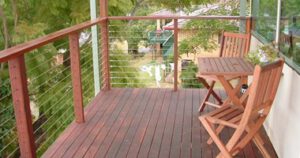Whether you’re planning on installing a new Decks Summerville SC you need to know the different types of decking materials available. You also need to know about the construction standards and design choices. Luckily, there are several resources available to assist you. Here are some of the top ones: Deck Designer, Deck Planner, and Deck Estimator.
There are many decking materials to choose from, including wood and plastic. Wood decking, for example, will need to be replaced more often than plastic decking, which is more durable. Plastic decking can be recycled and is available in a range of colors. Composite decking materials, such as Trex, combine wood fibers with plastic for a natural look. They are also environmentally friendly and will last a long time.
Another popular material for decks is pressure-treated lumber. It is inexpensive and rot-resistant and is available all across the state. It can last up to 15 years, but it’s easy to splinter if you don’t maintain it properly. Make sure to wear gloves and a dust mask when working with pressure-treated lumber. Also, never burn it because the wood is laced with toxic chemicals that are harmful to the environment. For the best results, use stainless steel fasteners.
If you’d like a wood deck without any of the maintenance problems associated with pressure-treated pine, you can opt for exotic hardwoods. These types of woods are very dense and hard and are very resistant to rot and infestation. They also have natural tannins, which work similarly to the chemicals added to pressure-treated lumber.
Cedar is another popular option. While cedar may be softer than other decking materials, it’s very durable and lightweight, which makes them a popular choice. Cedar is also resistant to insect damage and decay. For those who want a more natural look, cedar is often the best choice. Cedar is available all across the United States, and it’s a great choice for decking.
While wood is one of the oldest decking materials, it’s not as durable or low-maintenance as modern composites. It comes in a range of types and colors. Pressure-treated wood decking is the most common and is slightly more durable than composites. You can also choose exotic hardwoods for their exotic color and durability.
When building a deck, it’s important to follow the appropriate construction standards for your location. For instance, it’s important to use pressure-treated lumber and weather-resistant fasteners. Additionally, decks must be built with multiple 2×4 to 2×12 boards. Deck rails must be at least 36 inches high, and side rails must be at least four inches apart.
Fasteners for decks must be stainless steel, or hot-dipped galvanized to resist corrosion. They also need to conform to the manufacturer’s instructions. In addition, fasteners and connectors exposed to salt water must be stainless steel grade 304 or 316. These fasteners and connectors must be approved by the appropriate authority before installation.
Posts must be a minimum of six inches in diameter. Column posts can be less than six feet tall. If they’re longer, they should have an additional eight inches of spacing between them. Posts that are eight feet high or more must be anchored to the foundation using bolts or nuts that are no more than four inches wide.
For a deck to withstand the weather, wood lumber must be a high-grade wood. The lumber must also be treated for the climate in which the deck is constructed. Additionally, ground-contact parts of the deck must be treated to prevent rot. The lumber dimensions vary according to the size of the deck, as well as any municipal requirements.
Depending on the type of deck, construction standards can be quite complicated. However, with a deck chart to guide you, the process can be made simpler. These charts provide the maximum length for joists, posts, and beams, as well as variations for different lumber types and footings. Generally, decks built to code can support fifty pounds per square foot of weight. This standard is not sufficient to support most hot tubs, so it’s important to check the dimensions of your hot tub.
